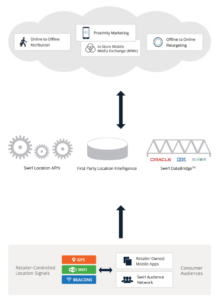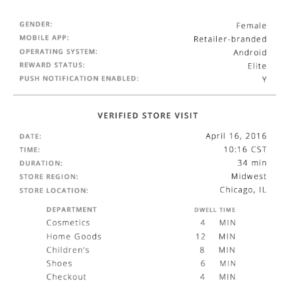Swirl: Maximizing Value from Brick and Mortar Stores Using Micro-Location Technology

The rise of e-commerce challenges brick and mortar stores to innovate and find new ways to engage consumers. Digital location technology (GPS, WiFi and Bluetooth beacons) enables retailers to collect rich consumer behavior datasets and personalize the in-store shopping experience. However, many retailers find deploying such new technologies prohibitively expensive due to a lack of know-how and the relatively high cost of IT professionals [1]. Swirl, the Boston-based micro-location marketing start-up, aims to bridge this gap by providing end-to-end solutions to retailers.
Micro-Location Technology
GPS, WiFi and Bluetooth beacons locate consumers at varying proximity to the store driving different use cases. Based on the consumers’ GPS signal, retailers can target consumers already in the neighborhood and convince them to enter the store. Once consumers connect to the store’s WiFi network, retailers can push targeted offers to them. Bluetooth beacons take this a step further by identifying the specific location of the consumer in the store, i.e. aisle or department. Beacons are small wireless devices placed around the store that emit signals the consumers’ smartphones can pick up via Bluetooth [2]. By capturing detailed information on the consumers’ movement in stores and the time spent in certain locations, retailers learn more about consumer preferences and needs. The database built up based on these location signals can be used to target offers, attribute online purchases to in-store visits and more.
Exhibit 1. Example consumer information captured by Swirl:
Swirl’s value proposition [3]
Swirl makes it simple for retailers to get started with micro-location technology providing a complete mobile presence solution. Depending on the current capabilities of the retailer, Swirl sets up its own-branded beacons or connects the retailers existing location signal devices to its platform. The mobile presence data captured is pushed to the retailers’ existing customer databases to enhance omnichannel marketing. Additional Swirl modules focus on creating and optimizing in-store marketing campaigns delivering offers both via the retailers’ own app and that of its audience network partners, e.g. Twitter [4].
Delivering on the promise
The key differentiating components of Swirl’s strategy are the following:
- Swirl supports all location signals. Many competitors, for example Footmarks, are betting on Bluetooth beacons alone [5]. Bluetooth beacons may appear superior technology given the more precise location. However, Swirl is approaching a broader consumer base with a more holistic offering supporting GPS and WiFi signals as well. This optionality adds complexity to the technology platform, but reinforces Swirl’s objective to provide a complete mobile presence solution.
- Swirl offers its own-branded hardware and modular software. Several competitors provide hardware only catering to retailers that have the knowledge and financial resources to deliver custom software in-house. For example, Target developed its own micro-location marketing solution [6]. Developing hardware is challenging even for an established software company, as we have learned in our Valve case [7]. However, to provide a complete mobile presence solution, it is important that Swirl developed its own hardware to offer retailers that do not yet have beacons set up.
- Swirl relies on strong partnerships for its audience network offering and database integration. Delivering offers via partner’s popular apps in addition to the retailers’ own app multiplies Swirl’s value. The ability to integrate the mobile presence data from Swirl into the retailers’ other consumer databases is essential for a multichannel proposition. Investing in these partnerships have been critical to Swirl’s success.
Exhibit 2. Swirl’s complete mobile presence solution:

Limitations and additional steps
Micro-location marketing solutions and Swirl face many challenges:
- Given the prevalence of mobile data, consumers may not connect to a retailer’s WiFi network any more. Furthermore, if a consumer doesn’t keep Bluetooth on, beacons will not pick up their location. Even if the consumer connects to Bluetooth, they may not have the relevant apps downloaded or running in the background. Essentially a consumer is unlikely to see offers from a retailer unless if they make an effort to see those offers. Hence the offers must compensate the consumers for sharing their information and keeping their connection on.
- Data protection regulations, particularly in Europe, are an obstacle to harnessing the full power of micro-location marketing. Customers must opt-in to receive location-based offers. Offering incentives to consumers to opt-in may be necessary, but this currently falls outside of the scope of Swirl’s work.
- Omnichannel is still a challenge for many retailers [8]. As such, they may choose to address this problem first before even considering micro-location marketing. However, if consumers are not enticed to visit physical stores, e-commerce may take over without Swirl ever getting a chance to prove there is more value to be found in-store.
Word count: 774
[1] Natasha Baker, “5 Tech Trends That Will Hit Every Retail Store by 2020”, Forbes, 3 Apr 2015, http://www.forbes.com/sites/centurylink/2015/04/03/5-tech-trends-that-will-hit-every-retail-store-by-2020/#44724d543784 accessed on 14 Nov 2016
[2] Dejan Jurejevcic, “IoT tech deep-dive: the rise of beacon technology”, IoT Analytics, 3 Sep 2015, https://iot-analytics.com/rise-of-beacon-technology/ accessed on 14 Nov 2016
[3] “The Ultimate Retail Marketing Advantage”, Swirl website, https://www.swirl.com/retail-marketers/ accessed on 14 Nov 2016
[4] Lizette Chapman, “Twitter Ventures Backs Micro-Location Startup Swirl in $18M Round”, Dow Jones Institutional News, 23 Apr 2015, https://global-factiva-com.prd2.ezproxy-prod.hbs.edu/ha/default.aspx#./!?&_suid=147915831118507869850016642397 accessed via Factiva on 14 Nov 2016
[5] “Solutions: Secure Enterprise Beacon Platform”, Footmarks website, https://www.footmarks.com/solutions/ accessed on 14 Nov 2016
[6] “Testing, Testing, 1,2,3: Beacon Technology Arrives in 50 Target Stores”, Target website, 5 Aug 2015, https://corporate.target.com/article/2015/08/beacon-technology accessed on 14 Nov 2016
[7] Ethan Bernstein, Francesca Gino, Bradley Staats, “Opening the Valve: From Software to Hardware (A)”, HBS Case 9-415-015
[8] Jeff Simpson, Lokesh Ohri, Kasey M Lobaugh, “The new digital divide: The future of digital influence in retail”, Deloitte University Press, https://dupress.deloitte.com/dup-us-en/industry/retail-distribution/digital-divide-changing-consumer-behavior.html accessed on 14 Nov 2016
Images:
Cover: “Problem Solved: A CMO’s Dream”, Enage.cx website, http://www.engage.cx/wearables-as-customer-experience-technology/ accessed on 14 Nov 2016
Exhibit 1: “The Ultimate Retail Marketing Advantage”, Swirl website, https://www.swirl.com/retail-marketers/ accessed on 14 Nov 2016
Exhibit 2: “The Retail Industry’s Most Advanced Mobile Presence Management and Marketing Platform”, Swirl website, https://www.swirl.com/products/ accessed on 14 Nov 2016




Beacons were certainly a hot topic at Red Bull a few years ago. A lot of our key retailers (like 7-11 and Walmart) were exploring integrating this technology into their apps. It held promise for suppliers (like us) who wanted to explore digital coupons and messaging in-store. The key challenge, like you mention, is that it’s not such a seamless process for the customer due to the fact that they have to download the appropriate app beforehand. I think the really interesting part of this from a supplier standpoint is observing the “customer path” inside of a store. We usually conduct studies on a small sample size for our “customer path” analysis, but if beacon technology gains traction, we would have a much larger sample size to work with.
Great article, thanks! I agree that beacon technology has some cool applications, but think that the wi-fi, bluetooth, and location service enabled app requirements are a bit of a stretch. I believe there are some beacon technology companies that no longer require wi-fi, such as Xone Beacon Network (http://marketingland.com/yext-launches-xone-beacon-network-for-offline-to-online-retargeting-144502). In addition to tracking customer movement, I think beacons provide an interesting opportunity to engage with customers. For example, if a beacon were to pick up a customer lingering in the home decor section at Target, Target could push a coupon for 50% of a picture frame to the customer’s phone.
While I find the idea really interesting from a conceptual and technological view point, as a potential customer, I am a bit concerned. I think many people, especially in Europe are a bit worried of how sophisticated companies are becoming at drawing us towards the products they want us to buy, often without us even noticing. This is why I think retailers could benefit from starting with a sufficiently long period of dedicated pilots in which they understand customers’ range of perceptions and reactions and then think of how they can tailor the user interaction and message in a way that generates positive reactions.